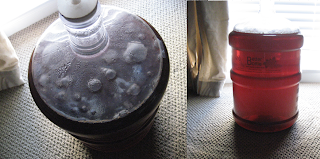Next it is cherry time but in San Diego we really only have sweet cherries available fresh to us. Trust me I searched a lot of produce markets and called even the professional breweries that make a cherry beer. In most krieks they use sour or tart cherries. After my search I was left with a few options:
1. Order tart cherries online and shipped frozen (or juice)
2. Buy canned tarts in water/syrup
 For this little experiment ordering online was far too expensive. So I found some tart cherries in light syrup at a local ethnic market (North Park Produce). Now these cherries are pitted and I have read about the complexity/nuttiness that can be added from the pits. So I decided to also buy some fresh sweet cherries. So I froze the fresh cherries for a few days to break down cell walls. I have decided to do a double dosing of cherries for this beer. The reason for this is to give the dregs some new sugar to start on but then I will also want some fresh cherries flavor also so I will add a month or so before bottling So to start I added .5 lb of the tart cherries and .5 lb of the frozen sweet cherries to a 1 gal container then racked my Summer Solstice beer on top. I put that into the beer fridge at 60 and added the dregs from an Old Beersel Framboise. I'm not sure how well these dregs will do since there didn't seem to be a lot. I will let this go about a month to see if I get any pellicle, if not I have a 750 bottle of Cantillon Kriek (I might add it regardless). So I'll update this entry as we progress.
For this little experiment ordering online was far too expensive. So I found some tart cherries in light syrup at a local ethnic market (North Park Produce). Now these cherries are pitted and I have read about the complexity/nuttiness that can be added from the pits. So I decided to also buy some fresh sweet cherries. So I froze the fresh cherries for a few days to break down cell walls. I have decided to do a double dosing of cherries for this beer. The reason for this is to give the dregs some new sugar to start on but then I will also want some fresh cherries flavor also so I will add a month or so before bottling So to start I added .5 lb of the tart cherries and .5 lb of the frozen sweet cherries to a 1 gal container then racked my Summer Solstice beer on top. I put that into the beer fridge at 60 and added the dregs from an Old Beersel Framboise. I'm not sure how well these dregs will do since there didn't seem to be a lot. I will let this go about a month to see if I get any pellicle, if not I have a 750 bottle of Cantillon Kriek (I might add it regardless). So I'll update this entry as we progress.12/4/10 Update - Added Cantillon dregs
12/11/10 Update - Taste and Aroma are mild cherry. Still very clean, hopefully new dregs will help. The color is great. I will add more tart cherries in a few months.





























